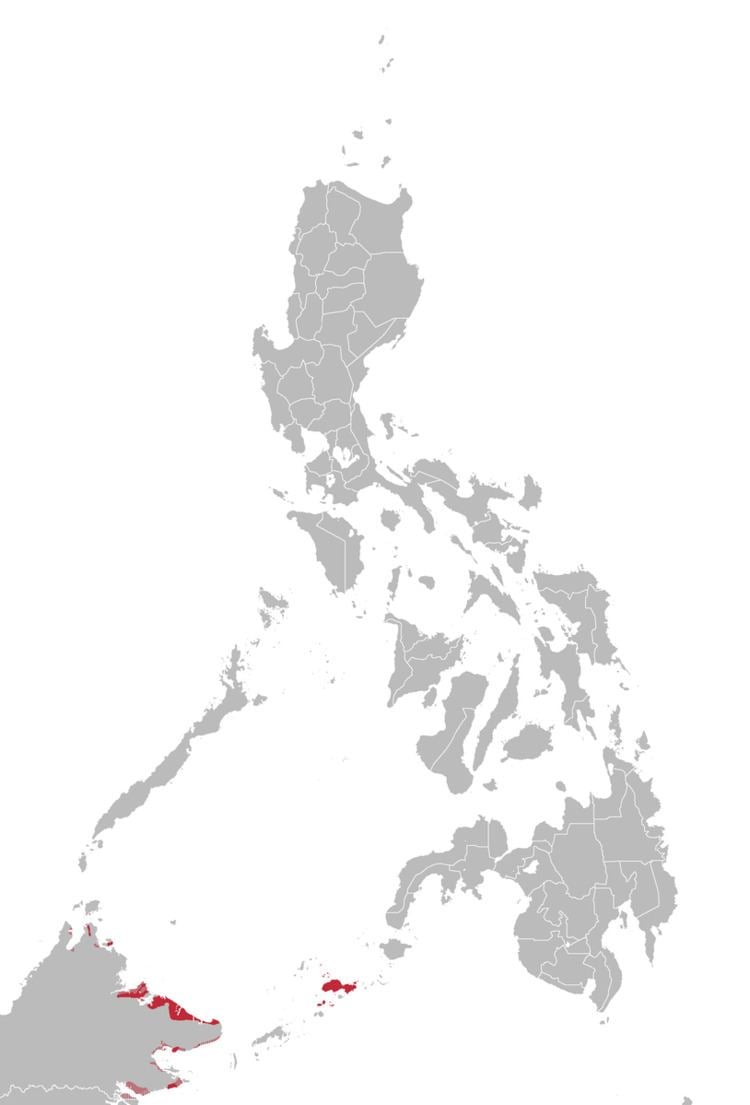Native speakers 1.1 million (2000) | ||
 | ||
Native to Philippines, Malaysia, Indonesia Region — Spoken throughout the Sulu Archipelago and eastern Sabah
— Also spoken in Zamboanga City and North Kalimantan (Indonesia) Ethnicity Tausūg people
Filipinos in Indonesia
Filipinos in Malaysia Language family Austronesian
Malayo-Polynesian
Philippine
Central Philippine
Visayan
Southern Visayan
Tausug Writing system Latin (Malay alphabet)
Arabic (Jawi) | ||
Tausug (Tausug: Bahasa Sūg, Malay: Bahasa Suluk, Filipino: Wikang Tausug) is a regional language spoken in the province of Sulu in the Philippines, in the eastern area of the state of Sabah, Malaysia, and in North Kalimantan, Indonesia by the Tausūg people.
Contents
It is widely spoken in the Sulu Archipelago (Basilan, Sulu and Tawi-Tawi), Zamboanga Peninsula (Zamboanga del Norte, Zamboanga Sibugay, Zamboanga del Sur, and Zamboanga City), Southern Palawan, Malaysia (eastern Sabah) and Indonesia (North Kalimantan). Tausug and Chavacano are the only Philippine languages spoken on the island of Borneo.
The Tausug language is very closely related to the Surigaonon language of the provinces Surigao del Norte, Surigao del Sur and Agusan del Sur, and to the Butuanon language of northeastern Mindanao.
Name of the language
The name of the language in Tausug is Bahasa Sūg, which means 'language of Sulu'. The word Tausūg is derived from two words "Tau" which means "person", and "sūg" which means "current", presumably referring to their economic livelihood depending on the strong currents of the Sulu Sea where they used to trans-navigate as fishermen, pearl divers and traders. The Sulu Sea has been use as the strategic trade route of the southern Philippines and other neighboring ASEAN nations, even up to the present time. As early as the 10th century it was believed that there was already flourishing trade route between Sulu with China and North Borneo. Basically the people in this area were known as "people of the current", which is the literal translation of "Tausūg".
Consonants
Features: Gemination of all non-glottal consonants
Vowels
Features: Vowel lengthening (e.g. bāy ‘house’). Stress: Nonphonemic stress on final syllable.
Diphthongs: aw, uy, ay, iw
Script
It is alleged that the Tausug language was previously written in a Baybayin-related script called "Luntarsug." The former Sultan of Sulu appears to have confirmed this view with physical evidence. The Tausūg language was previously written with the Arabic alphabet. The script used was inspired by the use of Jawi in writing the Malay language.
An example of the Arabic alphabet in writing the Tausūg language:
The Arabic script used to write the Tausug language differs in some aspects to the script used for the Arabic language and in the Jawi script used for Malay languages. One of the main differences is in the way that word-initial vowels are written.
In Arabic, /in/ is (إن); in Jawi (Malay), it is (ان). In Tausug, it is (ئِن). The Tausug Arabic script utilises the letter yā' with a hamza to represent a short vowel. If a kasra (ِ) is added, it becomes an 'i' sound. If a fatha (َ) is added, it becomes an 'a' sound. If a damma (ُ) is added, it becomes a 'u' sound.
Examples:
Loan words
Many Tausug words derive from the Arabic language.
Some examples of Arabic words in Tausug are
Tausug words derived from Sanskrit
